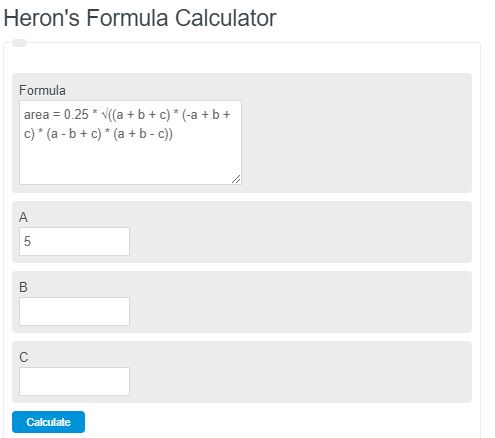Enter the three sides of a triangle into the calculator. The calculator will evaluate and display the area using Heron’s formula.
Heron’s Formula
The following formula is used to calculate the area of a triangle.
area = 0.25 * √((a + b + c) * (-a + b + c) * (a - b + c) * (a + b - c))
- Where a, b, and c are the lengths of the sides of the triangle.
Heron’s Formula Definition
Heron’s Formula is a mathematical formula used to calculate the area of a triangle when only the lengths of its sides are known. It is important because it provides a simple and efficient way to find the area of any triangle, regardless of its shape or angles.
By using Heron’s Formula, we can avoid complex trigonometric calculations and rely solely on the lengths of the sides. This makes it a valuable tool in various fields, such as architecture, engineering, and surveying, where the area of triangles needs to be determined accurately and quickly.
Heron’s Formula Example
How to calculate heron’s formula?
- First, measure side A.
Measure the length of side A.
- Next, measure side B.
Measure the length of side B.
- Next, measure side C.
Measure the length of side C.
- Finally, calculate the area.
Using heron’s formula, calculate the area of the triangle.
FAQ
What are the prerequisites for using Heron’s Formula?
To use Heron’s Formula, you must know the lengths of all three sides of the triangle. It is not necessary to know the angles or height of the triangle.
Can Heron’s Formula be used for all types of triangles?
Yes, Heron’s Formula can be used to calculate the area of any triangle, as long as the lengths of all three sides are known, regardless of the type of triangle (acute, obtuse, or right).
Is there a condition where Heron’s Formula cannot be applied?
Heron’s Formula cannot be applied if the sum of the lengths of any two sides of the triangle is less than or equal to the length of the third side, as such measurements do not form a valid triangle.
Why is Heron’s Formula important in fields like architecture and engineering?
Heron’s Formula is crucial in these fields for its ability to efficiently calculate the area of irregular land plots, components, or spaces, which assists in planning, design, and resource allocation without needing complex geometric or trigonometric calculations.

